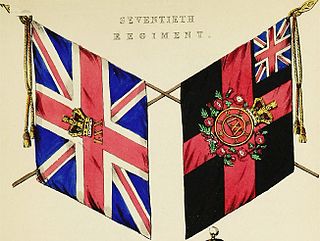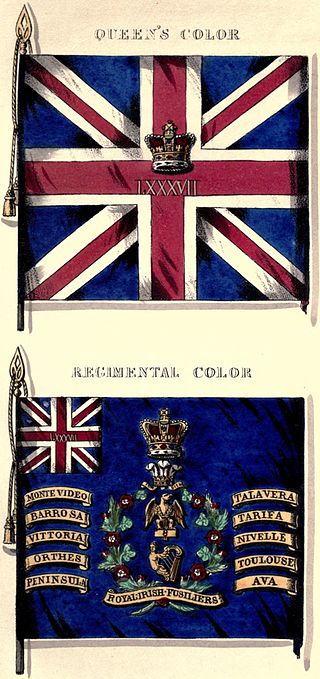Related Research Articles

Prince William Frederick, Duke of Gloucester and Edinburgh was a great-grandson of King George II of Great Britain and the nephew and son-in-law of King George III. He was the grandson of both Frederick, Prince of Wales, and Edward Walpole. Prince William married Princess Mary, the fourth daughter of George III.
The 47th (Lancashire) Regiment of Foot was an infantry regiment of the British Army, raised in Scotland in 1741. It served in North America during the Seven Years' War and American Revolutionary War and also fought during the Napoleonic Wars and the Crimean War. Under the Childers Reforms it amalgamated with the 81st Regiment of Foot to form the Loyal Regiment in 1881.

The 55th Regiment of Foot was a British Army infantry regiment, raised in 1755. After 1782 it had a county designation added, becoming known as the 55th (Westmorland) Regiment of Foot. Under the Childers Reforms it amalgamated with the 34th (Cumberland) Regiment of Foot to form the Border Regiment in 1881.

The 92nd Regiment of Foot was a British Army infantry regiment, raised in 1794. Under the Childers Reforms it amalgamated with the 75th (Stirlingshire) Regiment of Foot to form the Gordon Highlanders in 1881.
The 84th Regiment of Foot was a regiment in the British Army, raised in 1793. Under the Childers Reforms it amalgamated with the 65th Regiment of Foot to form the York and Lancaster Regiment, with the 84th becoming the 2nd Battalion, in 1881.

The 70th (Surrey) Regiment of Foot was a regiment of the British Army, raised in 1756. Under the Childers Reforms it amalgamated with the 31st (Huntingdonshire) Regiment of Foot to form the East Surrey Regiment in 1881.
Two regiments of the British Army have been numbered the 115th Regiment of Foot:
The 69th Regiment of Foot was an infantry regiment of the British Army, raised in 1756. Under the Childers Reforms it amalgamated with the 41st (Welch) Regiment of Foot to form the Welch Regiment in 1881.

The 39th (Dorsetshire) Regiment of Foot was an infantry regiment of the British Army, raised in 1702. Under the Childers Reforms it amalgamated with the 54th Regiment of Foot to form the Dorsetshire Regiment in 1881.
The 129th Regiment of Foot was an infantry regiment of the British Army. It was created in 1794 and disbanded in 1796. The regiment was raised at Coventry, and was originally titled the Gentlemen of Coventry's Regiment of Foot, being retitled the 129th a few days later.
The 123rd Regiment of Foot (Loyal Lincolnshire) was an infantry regiment of the British Army, formed in 1794 and disbanded in 1796; it took its title from the 100th Foot, disbanded in 1785.
The 122nd Regiment of Foot was an infantry regiment of the British Army, formed in 1794 and disbanded in 1796.
The 121st Regiment of Foot was an infantry regiment of the British Army, formed in 1794 and disbanded in 1796.

The 87th Regiment of Foot was an infantry regiment of the British Army, raised in 1793. Under the Childers Reforms it amalgamated with the 89th Regiment of Foot to form the Princess Victoria's in 1881.
The 115th Regiment of Foot (Royal Scotch Lowlanders) was an infantry regiment of the British Army from 1761 to 1763.
The 114th Regiment of Foot was an infantry regiment of the British Army from 1794 to 1795. It was raised in April 1794 and was disbanded the following year.
The 109th Regiment of Foot (Bombay Infantry) was an infantry regiment of the British Army from 1862 to 1881, when it was amalgamated into The Prince of Wales's Leinster Regiment (Royal Canadians).
The 113th Regiment of Foot was an infantry regiment of the British Army from 1794 to 1795.
The 110th Regiment of Foot was an infantry regiment of the British Army from 1794 to 1795.
References
- ↑ "115th Regiment of Foot". regiments.org. Archived from the original on 10 October 2007.